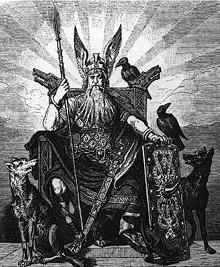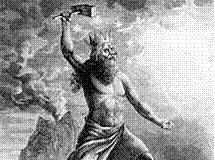
Asatru (ahh-sa-true) is the ancient and religion of the Norse/Teutonic people of Northern Europe. That is, the Scandinavian, English, German, Dutch, etc. people practiced this belief before the coming of Christianity. To give one an idea of how much this belief was a part of our past, the very days of our week are named after the Gods and Goddesses of Asatru (i.e. Tuesday-Tyr, Wednesday-Odin, Thursday-Thor, Friday-Frigga).
Many people today practice this ancient religion. They sometimes organize into groups called "Kindreds." Below are some links for anyone interested in learning more. One of my personal favorite links below is to the site of a really "cool" Asatruar by the name of Andrea Hagen! She is a musician, and she, and her band, "Hagalaz Runedance," create really enjoyable "New Age" style music! Check out her site for some downloadable songs from her CD's! She is also an author.
Below is some info I've gleaned on Norse/Teutonic Mythology.
Scandinavian Mythology
Scandinavian Mythology, pre-Christian religious beliefs of the Scandinavian people. The Scandinavian legends and myths about ancient heroes, gods, and the creation and destruction of the universe developed out of the original common mythology of the Germanic peoples and constitute the primary source of knowledge about ancient German mythology. Because Scandinavian mythology was transmitted and altered by medieval Christian historians, the original pagan religious beliefs, attitudes, and practices cannot be determined with certainty. Clearly, however, Scandinavian mythology developed slowly, and the relative importance of different gods and heroes varied at different times and places. Thus, the cult of Odin, chief of the gods, may have spread from western Germany to Scandinavia not long before the myths were recorded; minor gods—including Ull, the fertility god Njord, and Heimdall—may represent older deities who lost strength and popularity as Odin became more important. Odin, a god of war, was also associated with learning, wisdom, poetry, and magic.
Most information about Scandinavian mythology is preserved in the Old Norse literature (see Icelandic Literature; Norwegian Literature), in the Eddas and later sagas; other material appears in commentaries by the Danish historian Saxo Grammaticus and the German writer Adam of Bremen (flourished about 1075). Fragments of legends are sometimes preserved in old inscriptions and in later folklore.
Aesir
Aesir, the principal gods of Scandinavian mythology—Odin, Thor, Balder, Tyr, Heimdall, and Loki. Their dwelling place is Asgard. They fought against a rival group of gods, the Vanir, and as a result Njord, Freyr, and Freya joined them, initially as hostages.
Gods and Heroes
Besides Odin, the major deities of Scandinavian mythology were his wife, Frigg, goddess of the home; Thor, god of thunder, who protected humans and the other gods from the giants and who was especially popular among the Scandinavian peasantry; Frey, a god of prosperity; and Freya, sister of Frey, a fertility goddess. Other, lesser gods were Balder, Hermod, Tyr, Bragi, and Forseti; Idun, Nanna, and Sif were among the goddesses. The principle of evil among the gods was represented by the trickster Loki. Many of these deities do not seem to have had special functions; they merely appear as characters in legendary tales.
Many ancient mythological heroes, some of whom may have been derived from real persons, were believed to be descendants of the gods; among them were Sigurd the Dragon-slayer; Helgi Thrice-Born, Harald Wartooth, Hadding, Starkad, and the Valkyries. The Valkyries, a band of warrior-maidens that included Svava and Brunhild, served Odin as choosers of slain warriors, who were taken to reside in Valhalla. There the warriors would spend their days fighting and nights feasting until Ragnarok, the day of the final world battle, in which the old gods would perish and a new reign of peace and love would be instituted. Ordinary individuals were received after death by the goddess Hel in a cheerless underground world.
Scandinavian mythology included dwarves; elves; and the Norns, who distributed fates to mortals. The ancient Scandinavians also believed in personal spirits, such as the fylgja and the hamingja, which in some respects resembled the Christian idea of the soul. The gods were originally conceived as a confederation of two formerly warring divine tribes, the Aesir and the Vanir. Odin was originally the leader of the Aesir, which consisted of at least 12 gods. Together all the gods lived in Asgard.
Creation Myth
The Eddic poem Völuspá (Prophecy of the Seeress) portrays a period of primeval chaos, followed by the creation of giants and gods and, finally, of humankind. Ginnungagap was the yawning void, Jotunheim the home of the giants, Niflheim the region of cold, and Muspellsheim the realm of heat. The great world-tree, Yggdrasil, reached through all time and space, but it was perpetually under attack from Nidhogg, the evil serpent. The fountain of Mimir, source of hidden wisdom, lay under one of the roots of the tree.
Valhalla
Valhalla (Old Norse Valhöll,"hall of the slain"), in Old Norse mythology, the hall of slain heroes, ruled by the king of the gods, Odin, in the realm of the gods, Asgard. The hall had 540 doors, through each of which 800 heroes could walk abreast, and the roof was made of shields. The souls of heroic soldiers killed in battle were brought to Valhalla by warrior maidens called Valkyries. The heroes fought during the day, but their wounds healed before night, when they banqueted with Odin.
Asgard
Asgard, in Norse mythology, the abode of the gods. Access to Asgard was possible only by crossing the bridge Bifrost (the rainbow). Asgard was divided into 12 or more realms in which each principal god had his own luxurious mansion of gold or silver. The most important palace was Valhalla, the home of Odin, the chief of the gods.
Religious Ritual
The Scandinavian gods were served by a class of priest-chieftains called godar. Worship was originally conducted outdoors, under guardian trees, near sacred wells, or within sacred arrangements of stones. Later, wooden temples were used, with altars and with carved representations of the gods. The most important temple was at Old Uppsala, Sweden, where animals and even human beings were sacrificed.
Odin
Odin (Old Norse Odhinn, Anglo-Saxon Woden, Old High German Wodan, Woutan), in Norse mythology, king of the gods. His two black ravens, Huginn ("Thought") and Muninn ("Memory"), flew forth daily to gather tidings of events all over the world. As god of war, Odin held court in Valhalla, where all brave warriors went after death in battle. His greatest treasures were his eight-footed steed, Sleipner, his spear, Gungnir, and his ring, Draupner. Odin was also the god of wisdom, poetry, and magic, and he sacrificed an eye for the privilege of drinking from Mimir, the fountain of wisdom. Odin's three wives were earth goddesses, and his eldest son was Thor, the god of Thunder.
Thor
Thor, in Norse mythology, the god of thunder, eldest son of Odin, ruler of the gods, and Jord, the earth goddess. Thor was the strongest of the Aesir, the chief gods, whom he helped protect from their enemies, the giants. He had a magic hammer, which he threw with the aid of iron gloves and which always returned to him. Thunder was supposed to be the sound of the rolling of his chariot. Thursday is named for Thor.
Balder
Balder or Baldur, in Norse mythology, the god of light and joy, son of Odin and Frigga, king and queen of the gods. Having dreamed that Balder's life was threatened, Frigga extracted an oath from the forces and objects in nature, animate and inaminate, that they would not harm Balder, but she forgot the mistletoe. The gods, thinking Balder safe, cast darts and stones at him. The malicious giant Loki put a twig of mistletoe in the hands of Balder's twin, the blind Hoder, god of darkness, and directed his aim against Balder, who fell pierced to the heart. After the death of Balder, Odin sent another son, the messenger Hermod, to the underworld to plead for Balder's return. The god would be released only if everything in the world would weep for him. Everything wept except one old woman in a cave, and Balder could not return to life.
Freya
Freya or Freyja, in Norse mythology, goddess of love, fertility, and beauty, sometimes identified as the goddess of battle and death. Her father was Njord, a fertility god. Blond, blue-eyed, and beautiful, Freya traveled on a golden-bristled boar or in a chariot drawn by cats. She resided in the celestial realm of Folkvang, where it was her privilege to receive half of all the warriors slain in battle; the god Odin received the other half at Valhalla. In Germany, Freya was sometimes identified with Frigg, the wife of Odin.
Frigg
Frigg or Frigga, in Norse mythology, goddess of the sky and wife of Odin, the chief of the gods. She was worshiped as the protector of married love and housewives. A bunch of keys was her symbol. Frigg had two sons, Balder, the god of light, and Hoder, the blind god of darkness, who killed Balder with a mistletoe sprig. Frigg's name survives in the English word Friday (Frigg's day). In German mythology, Frigg was sometimes identified with Freya, the goddess of love.
Loki
Loki, in Norse mythology, the handsome giant who represented evil and was possessed of great knowledge and cunning. He was indirectly responsible for the death of Balder, god of light and joy. According to the Poetic Edda, a collection of Scandinavian myths, Loki and Hel, goddess of the underworld, will lead the forces of evil against the Aesir, or gods, in the titanic struggle of Ragnarok, the end of the world.
Hel
Hel, in Norse mythology, the goddess of the dead. She dwelt beneath one of the three roots of the sacred ash tree Yggdrasil and was the daughter of Loki, the spirit of mischief or evil, and the giantess Angerbotha (Angerboda). Odin, the All-Father, hurled Hel into Niflheim, the realm of cold and darkness, itself also known as Hel, over which he gave her sovereign authority.
Valkyries
 Valkyries, in Scandinavian mythology, warrior maidens who attended Odin, ruler of the gods. The Valkyries rode through the air in brilliant armor, directed battles, distributed death lots among the warriors, and conducted the souls of slain heroes to Valhalla, the great hall of Odin. Their leader was Brunhild. The Valkyries play an important part in the opera Die Walküre (The Valkyries, 1856) by the German composer Richard Wagner.
Valkyries, in Scandinavian mythology, warrior maidens who attended Odin, ruler of the gods. The Valkyries rode through the air in brilliant armor, directed battles, distributed death lots among the warriors, and conducted the souls of slain heroes to Valhalla, the great hall of Odin. Their leader was Brunhild. The Valkyries play an important part in the opera Die Walküre (The Valkyries, 1856) by the German composer Richard Wagner.
Links
Hagalaz Runedance
Asatru Alliance
Asatru Folk Assembly
Ring of Troth
Irminsul Aettir
Amon Amarth
Back to Top Home E-Mail Me
 Valkyries, in Scandinavian mythology, warrior maidens who attended Odin, ruler of the gods. The Valkyries rode through the air in brilliant armor, directed battles, distributed death lots among the warriors, and conducted the souls of slain heroes to Valhalla, the great hall of Odin. Their leader was Brunhild. The Valkyries play an important part in the opera Die Walküre (The Valkyries, 1856) by the German composer Richard Wagner.
Valkyries, in Scandinavian mythology, warrior maidens who attended Odin, ruler of the gods. The Valkyries rode through the air in brilliant armor, directed battles, distributed death lots among the warriors, and conducted the souls of slain heroes to Valhalla, the great hall of Odin. Their leader was Brunhild. The Valkyries play an important part in the opera Die Walküre (The Valkyries, 1856) by the German composer Richard Wagner.